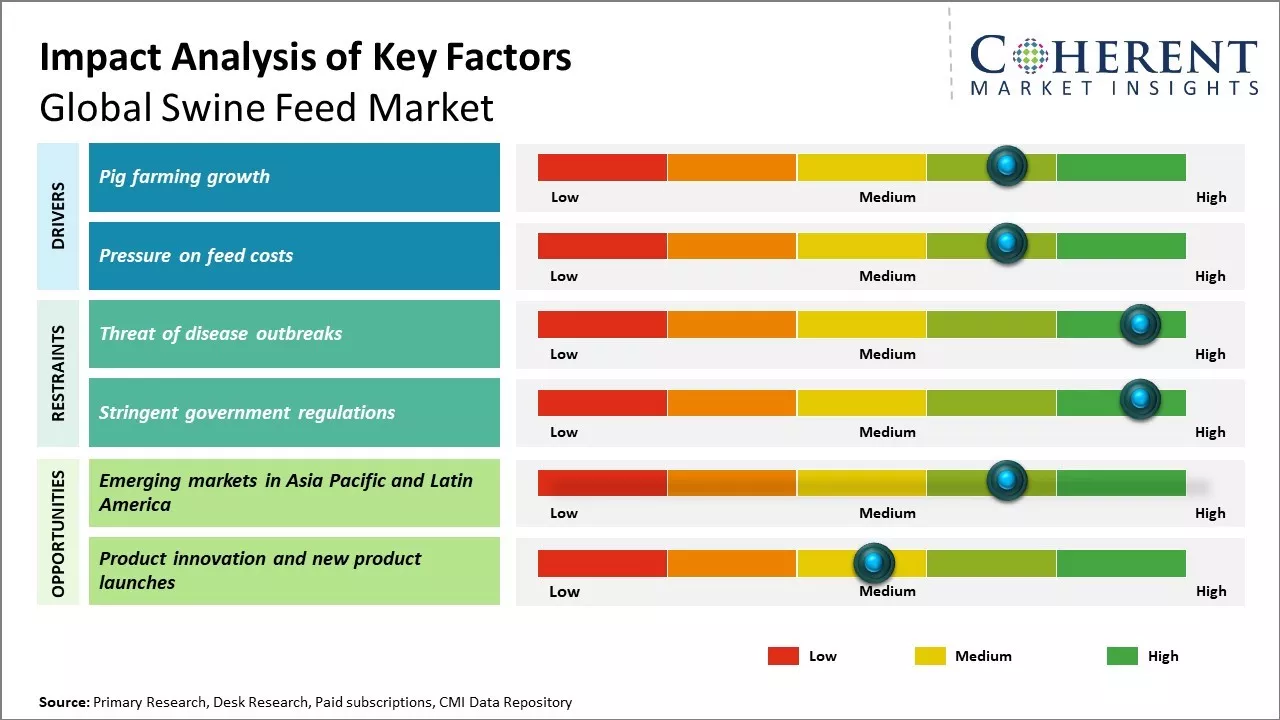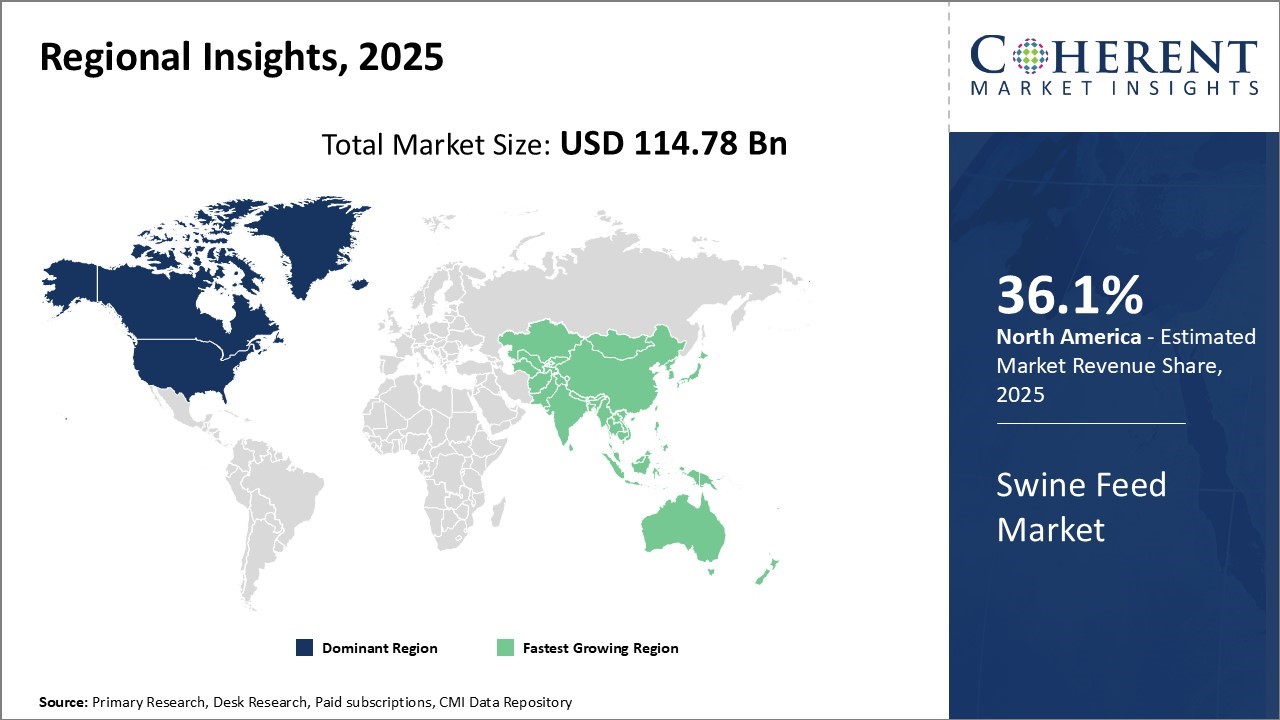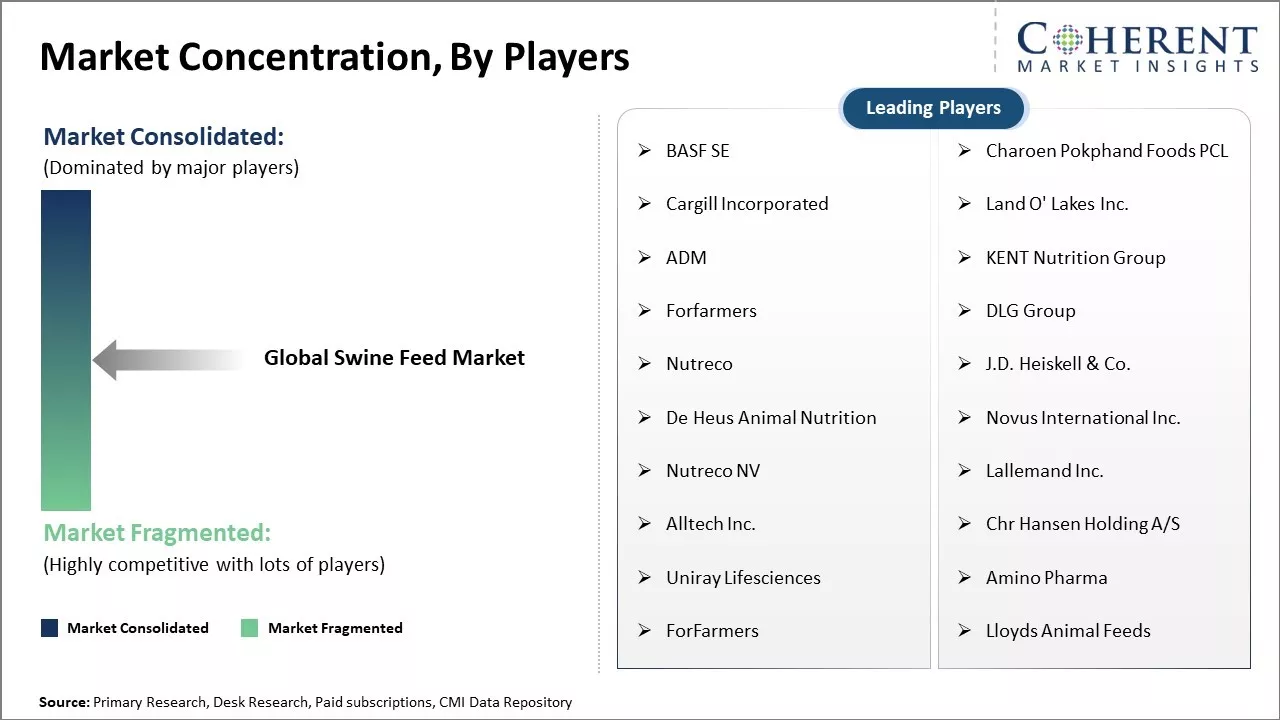The swine feed market is estimated to be valued at USD 114.78 Bn in 2025 and is expected to reach USD 156.31 Bn by 2032, exhibiting a compound annual growth rate (CAGR) of 4.5% from 2025 to 2032.

To learn more about this report, Download Free Sample
The global swine feed market is expected to witness positive growth over the forecast period. Increasing meat consumption worldwide primarily driven by rising population is expected to drive the demand for pork which, in turn, is expected to boost the swine feed market growth. Growth in the demand for animal protein coupled with rising disposable income especially in developing regions is expected to support the market demand. Additionally, various initiatives undertaken by government and market players to increase pork production are also expected to have a positive impact on the swine feed market. However, stringent regulations pertaining to the use of antibiotics and growth hormones in swine feed may hamper the market growth to some extent over the forecast period.
|
Current Event |
Description and its Impact |
|
African Swine Fever (ASF) Outbreaks and Regional Disease Pressures |
|
|
Technological Innovations in Feed Formulation |
|
Uncover macros and micros vetted on 75+ parameters: Get instant access to report
The global swine feed market continues to face notable price pressures, driven by rising costs of essential ingredients such as corn, soybean meal, wheat, and barley. As of mid-2025, corn prices averaged around $255 per metric ton, reflecting a 9.6% increase from the previous year, while soybean meal reached $468 per metric ton, up 6.2% year-over-year, due to tightening supplies from Brazil and rising demand, especially in Asia. Wheat used for feed purposes averaged $292 per metric ton, rising 7.8% YoY, influenced by supply chain disruptions in key producing regions like the Black Sea.
According to USDA estimates, feed represents approximately 65% to 75% of total pig production costs, making it a critical cost component for farmers. Amino acids such as lysine and methionine also experienced 5–10% price hikes in Q2 2025 due to strong demand and limited European output. Regionally, Southeast Asia saw finishing pig feed costs rise from $370 to $405 per metric ton between 2024 and 2025. In Europe, feed prices surged by 8–12% YoY, compounded by high energy costs and tighter environmental rules. North America saw relatively more stable costs, though still 6.5% higher than the five-year average. The adoption of sustainability-aligned ingredients like fermented soybean meal, insect protein, and algae-based formulations is also adding a premium, with specialty swine feed costing 10–18% more than conventional rations.
The swine feed market is witnessing notable international trade activity, particularly in the United States. U.S. export figures for pig feed products have increased by 6.1% in the year to date (Jan–May), driven by growing demand from key markets such as Mexico, Japan, and the Philippines. At the same time, imports of pig meat into the U.S. have grown 7.5% year-on-year during the same period, reflecting strong domestic demand for pork products and the need to stabilize supply chains. These trade movements highlight the interdependence between swine feed production and pork trade, with feed exports often following global pork consumption and production patterns. Additionally, fluctuating grain prices and sustainability standards are influencing sourcing strategies and the competitiveness of feed exports.
In terms of product type, grower feed segment is expected to contribute 36.9% share of the market owing to its ability to support optimal growth in young pigs. Grower feed is formulated to meet the nutritional needs of pigs from weaning until around 70 pounds. During this growth period, young pigs require balanced dietary levels of essential proteins, vitamins, and minerals to efficiently gain body mass and build strong bone structures. The feed composition is adjusted with a focus on muscle building and steady weight gain without excess fat deposition.
Most farmers prefer grower feed because it allows pigs to grow at their genetic potential in a short period of time. Optimal nutrient intake during the growing phase establishes a healthy foundation for pigs to thrive later in their lifecycle. Competitively priced grower rations ensure maximum returns from limited livestock housing space for farmers. Leading manufacturers focus on continuous feed formulation innovations to deliver the ideal nutrient profile supporting 1.5 to 2 pounds average daily gain in pigs.
For instance, diets fed during grower period are termed ‘medium density’, with 13.8–14.5 megajoules (MJ) of digestible energy per kilogram (DE/kg) and 0.68–0.74 g available lysine/MJ DE. The pig feed formulation ideal for medium-size pigs, contains corn meal 62%, soyabean meal 20%, rice bran or wheat bran 15%, calcium hydrogen phosphor 1.2%, shellac 0.8%, salt 0.35%, premix 1% (containing tract elements, vitamins, non-nutritive additives and many more).
In terms of ingredient, corn is expected to contribute 30% share of the market in 2025, owing to its widespread availability and balanced nutrient composition. Corn is one of the most accessible and affordable cereal grains globally, making it a predominant choice for swine feed formulations. It contains highly digestible starch, crude protein, fiber, trace minerals, and vitamins important for pig nutrition. The energy-rich carbohydrates in corn support optimal weight gain and muscle development in growing pigs. Corn protein consists of essential amino acids that complement soybean meal as a balanced dietary protein source. Phosphorus from corn also helps with bone mineralization in young animals.
For instance, in 2023, U.S. hogs consumed approximately 60.9 million tons of feed, with a significant portion derived from corn-related ingredients. Specifically, more than 77.8% of this total feed volume consisted of corn-related ingredients.
In terms of supplement, antibiotics is expected to contribute 30.8% share of the market in 2025, due to their utility as growth promoters and preventive disease control agents in pig production. During the post-weaning period, young pigs experience stress due to transportation, co-mingling with unfamiliar herd mates and changes in diet and environment. This transient immunosuppression often leads to increased incidence of digestive disorders and infectious diseases. Inclusion of low dosage antibiotics in starter and grower feed helps control opportunistic bacterial infections and promotes overall gut health in weanling pigs.
According to National Institute of Health, the use of antibiotics as antimicrobial growth promoters in pig diets is expected to increase weight gain by 4 to 16% and feed efficiency by 2 to 7%.

To learn more about this report, Download Free Sample
North America has remained the largest regional market for swine feed over the past decade. The region is expected to account for 36.1% of the market share in 2025. Led by the U.S., the region is home to many agricultural heavyweights and boasts a large-scale pork production sector. For instance, according to the Agriculture and Horticulture Development Board (AHDB), US pork production is forecast to increase by 3.1% year on year to 12.8 million tonnes in 2024.
Farmers in the U.S. rely heavily on specialized swine feeds to fuel efficient growth and maximize productivity of their large herd sizes. Proximity to corn - the primary feedstock - allows low-cost formulation of nutrient-dense swine rations. Large feed manufacturers have established a strong manufacturing footprint and distribution networks to cater to the industrialized farming system prevalent across the Midwest. Stringent specifications from meat processors have also propelled feed innovators to develop customized formulations to produce leaner meat profiles.
The Asia Pacific region has emerged as the fastest growing market for swine feed in recent years. Pork accounts for a significant part of the daily protein intake in many Asian diets. Pork consumption with Asian countries is popularly witnessed in Vietnam, China, and East Asia (Japan, South Korea and Taiwan). China leads the world in pork consumption, consuming around 55 million metric tons of pork annually Rapid economic development and urbanization and rising disposable incomes have lifted meat consumption across developing nations like China and Vietnam. Local producers are scaling up operations and adopting intensive rearing practices to meet this burgeoning domestic demand. However, feed mills still lag the maturation seen in the West, with imports filling the gap. Environmental regulations around the use of antibiotics are also less stringent compared to Europe and North America, providing options to manufacturers. Investments into localized feed manufacturing facilities and import terminals indicate efforts by global players to capitalize on Asia Pacific voracious appetite for pork and compound feed. The Animal Feed and Nutrition sector in Asia comprises 393 companies, including 21 funded companies having collectively raised $52.3M in venture capital money and private equity.
China remains the world’s largest pork producer and consumer, driving strong demand for high-quality, traceable commercial swine feed. Following the ASF outbreak, there's been a major shift from smallholder farms to biosecure, industrial-scale operations, increasing reliance on specialized feed.
Demand is further fueled by food safety regulations and consumer preferences for sustainable and antibiotic-free meat. For instance, China’s national breeding sow inventory will be reduced by 1 million from the current 40.38 million, to ease pork oversupply, signaling structural shifts in herd management and feed optimization needs.
The United States, as the world’s second-largest pork producer, is a major driver of the swine feed market. Growth is fueled by technological advancements in feed formulation, a strong export market, and increasing demand for sustainable, antibiotic-free diets. Producers are adopting precision nutrition strategies, enzymes (like phytase), and alternative proteins to improve efficiency and comply with EPA nutrient management regulations. This aligns with consumer and ESG expectations.
According to the USDA Foreign Agriculture Service data, U.S. swine feed production reached 12.39 million metric tons in 2023/2024, and is projected to increase to 12.61 million metric tons in 2024/2025, reflecting a 2% year-over-year growth. These trends firmly position the U.S. as a key contributor to the Swine Feed Market Forecast.

To learn more about this report, Download Free Sample
| Report Coverage | Details | ||
|---|---|---|---|
| Base Year: | 2024 | Market Size in 2025: | USD 114.78 Bn |
| Historical Data for: | 2020 To 2024 | Forecast Period: | 2025 To 2032 |
| Forecast Period 2025 to 2032 CAGR: | 4.5% | 2032 Value Projection: | USD 156.31 Bn |
| Geographies covered: |
|
||
| Segments covered: |
|
||
| Companies covered: |
BASF SE, Charoen Pokphand Foods PCL, Cargill Incorporated, Land O' Lakes Inc., ADM, KENT Nutrition Group, Forfarmers, DLG Group, Nutreco, J.D. Heiskell & Co., De Heus Animal Nutrition, Novus International Inc., Nutreco NV, Lallemand Inc., Alltech Inc., Chr Hansen Holding A/S , Uniray Lifesciences, Amino Pharma, ForFarmers, and Lloyds Animal Feeds |
||
| Growth Drivers: |
|
||
| Restraints & Challenges: |
|
||
Uncover macros and micros vetted on 75+ parameters: Get instant access to report
The growth of pig farming across major pork producing countries has been one of the key drivers for the swine feed market in recent years. There has been a significant rise in pork consumption globally due to increasing population, rising incomes, and changing food preferences. Countries like China, the U.S., Brazil, and Germany have seen huge increases in pig livestock numbers over the last decade alone. Pork is now becoming a widely consumed meat in many developing Asian and Latin American countries.
This rise in pig farming has encouraged farmers to expand their operations and increase herd sizes to meet the growing demand. Larger farms now house thousands of pigs and require huge volumes of specialized feed products. Feeding high-quality nutritional feed to commercial pig stocks is crucial for their optimal growth performance and timely production cycles. Farmers leave no stone unturned to source the best quality swine feed mixes and nutritional supplements. Leading feed producers have capitalized on this trend by introducing innovative formulations tailored for various growth stages of pigs. They also provide expert guidance to farmers for efficient feeding practices.
For instance, in July 2025, Arunachal Pradesh Agriculture Minister Gabriel Denwang Wangsu appealed to farmers in Longding district to shift from traditional small‑scale pig rearing to scientific, commercial piggery methods to enhance income and livelihood sustainability. Speaking at a Tribal Sub‑Plan awareness camp in Kanubari, organized in collaboration with ICAR‑NRC on Pig and ICAR‑KVK Longding, he underscored biosecurity and modern husbandry techniques. This is further proliferating the swine feed market revenue.
The growing emphasis on environmental sustainability is opening up significant opportunities in the swine feed market, particularly for eco-friendly and low-emission pig diets. As climate concerns rise and regulatory frameworks tighten across the globe, such as the EU Green Deal and U.S. EPA nutrient management policies, swine producers are being pushed to reduce their environmental footprint. This trend is expected to shape the swine feed market forecast, driving demand for sustainable feed solutions that minimize nitrogen and phosphorus excretion while maintaining animal performance.
One key development is the use of enzymes like phytase, which improves the digestibility of naturally occurring phosphorus in plant-based feed ingredients. These sustainable feed practices not only help swine producers comply with stricter environmental regulations but also align with consumer demand for eco-conscious animal protein. Additionally, many companies are leveraging these practices to meet their ESG (Environmental, Social, and Governance) goals and gain a competitive edge in markets increasingly dominated by sustainability-conscious buyers. Ultimately, the adoption of eco-friendly swine feeds offers a pathway toward more responsible, efficient, and future-ready pork production systems.
For instance, DSM‑Firmenich highlights the advanced capabilities of RONOZYME® HiPhos, its latest-generation phytase enzyme designed for monogastric and aquaculture animal nutrition. Engineered to dramatically boost plant‑derived phosphorus availability, HiPhos significantly reduces the need for inorganic phosphate additives, cutting feed costs while supporting sustainability.
The swine feed market value is undergoing a pivotal transformation, driven by regulatory tightening, climate-linked scrutiny, and a distinct shift in feed formulation innovation.
Environmental imperatives are no longer peripheral—they are central to procurement decisions. In the EU, for example, the tightening of nitrate directives and pressure to reduce ammonia emissions from livestock farming are pushing producers toward low-protein, amino acid-fortified feeds. According to the European Feed Manufacturers' Federation (FEFAC), crude protein levels in swine diets have already declined by 2–3% over the last five years in major markets such as Denmark and the Netherlands, driven largely by synthetic amino acid inclusion (e.g., L-lysine, L-threonine). This isn’t a transient cost-control measure, it’s a structural recalibration of feed strategy to align with emission quotas.
Equally notable is the rapid advancement of feed enzyme technologies. Enzyme innovations such as phytase, xylanase, and protease are enabling higher feed conversion efficiency (FCR) and nutrient absorption in non-GMO and antibiotic-free diets. DSM-Firmenich’s launch of RONOZYME HiPhos is a case in point, it claims to reduce phosphorus excretion by up to 30% while maintaining performance, a capability that aligns tightly with environmental compliance in the U.S. and Europe.
Geopolitically, nations like China are accelerating their swine industry consolidation post-ASF (African Swine Fever), with large integrators aggressively adopting precision feeding systems. Companies such as Muyuan Foods and New Hope Liuhe are deploying AI-enabled feed optimization systems, which are enabling nutrient targeting at the pen-level. This is altering demand patterns—less about feed tonnage, more about nutrient delivery and digital integration. Consequently, feed manufacturers that fail to embed data-driven formulation into their value proposition will face disintermediation.
Additionally, the rising cost of conventional ingredients, such as soybean meal and corn is reshaping feed composition. The U.S. Department of Agriculture’s 2025 grain outlook projects sustained volatility, prompting integrators in Vietnam, Brazil, and the Philippines to increase local procurement of cassava, distillers dried grains with solubles (DDGS), and fermented soybean meal. This ingredient shift is not merely economic, it has cascading implications on premix design, gut health strategies, and feed mill technology upgrades.
*Definition: The swine feed market consists of companies that manufacture and sell feed for pigs and hogs. This includes balanced nutritional formulas made from grains like corn and soybean meal as well as additives that improve digestion, growth, and overall health. Key components are proteins, calories from carbohydrates and fats, vitamins, minerals, and essential amino acids. The swine feed industry supplies both commercial livestock operations and small backyard pig farms. Product selection ranges from starter feeds for young piglets to complete feeds for breeding and market swine.
Share
Share
Missing comfort of reading report in your local language? Find your preferred language :
Transform your Strategy with Exclusive Trending Reports :
Frequently Asked Questions
Joining thousands of companies around the world committed to making the Excellent Business Solutions.
View All Our Clients